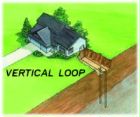In addition to having state-of-the-art laboratories and equipment, Hamilton's new Science Center is being built with attention to environmental benefits. Much of the new building will be constructed with attention to "green" design, which is the use of environmentally friendly processes and materials in building construction and design.
"From the beginning of the discussions of the new Science Center, there was an interest in having a building that was sensitive to environmental concerns and that met the spirit of being a green building," said Douglas A. Weldon, Stone Professor of Psychology and science curriculum and facilities coordinator. "During the conceptual design phase, a committee called the Green Team was formed, consisting of Hamilton faculty from a variety of science and non-science departments, staff, administrators, and the Einhorn Yaffee Prescott architects and engineers."
This Green Team selected a number of areas of the building that will be highlighted for green design. All wood in casework and millwork in the building is certified as meeting forest stewardship standards, and strategically placed glass, skyroof and clearstories yield substantial day lighting.
Another area that was targeted for green design is the atrium, which will include a geothermal system that, according to Weldon, "will play a significant role in the heating and cooling."
Geothermal systems utilize the warmth of the earth to both heat and cool buildings much more efficiently than conventional furnaces or air conditioners.
The Science Center will employ a "vertical loop" configuration in which boreholes of up to 1,500 feet deep and six inches in diameter are drilled near the property site. Piping and a synthetic heat conductor are then fed into the boreholes, creating one loop. The loop, or any number of loops, is then connected to a heat pump, which is in turn connected to a forced-air system and a water heater. Water or an anti-freeze type substance is pumped through the loop, gaining heat as it passes through during the winter months, or expelling excess heat to the earth during the summer months. The process requires only electricity to run a heat pump and eliminates the use of costly natural gas.

One of the issues encountered during planning was the feasibility of a geothermal system. Fifteen boreholes of 450-feet deep are planned for the project, costing upwards of $100,000. The efficiency of the geothermal system is its overwhelming advantage. While conventional heating and cooling devices must convert outside temperatures almost 30 degrees to reach comfort levels, geothermal heating and cooling convert about half of that amount.
While less expensive green heating and cooling methods were considered, such as solar energy, the Green Team chose a geothermal system based on several factors. "We had discussed the idea of solar panels," said Weldon, "but the efficiency of the current system was not adequate to provide a sufficient output to be helpful in this particular space. Since the objective was to provide education about green technology, the payback was a consideration but not a limiting factor in the decision to include a geothermal system in the design of the atrium." Weldon estimates the system will pay for itself in 25 years.
Research and testing was conducted by Geothermal Services, Inc. of New Jersey in Fall 2002. The company drilled a test borehole to determine the conductivity of the earth surrounding the proposed Science Center site. The geothermal system was given the green light after positive research results and the system will be installed during Phase II of construction, which is slated for Fall 2004.
--by Jesse Hooker
Posted March 25, 2004
